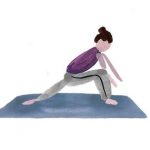Who doesn’t remember those awkward teenage years where you had to get changed for gym, sports or swimming alongside your peers. Trying to hide what you did or didn’t have and the awkwardness of trying to get dressed under a towel before it slipped down. Are you happy with your body as it is today?
The Body Positive movement has been growing quickly over the last few years. You just have to search the hashtags #bodypositive #bodypositivity to see millions of pictures of women of all shapes and sizes. In 2009, in a now infamous article for WWD, the model Kate Moss was quoted as saying ‘Nothing tastes as good as skinny feels’. It caused furore not least because it was a mantra quickly taken up those championing eating disorders. However, furore aside, lots of us have been there. We’ve lost a few pounds and felt delighted that we can fit into a new pair of jeans. As parents, accepting ourselves whilst also teaching our children acceptance of who they are, is part of our everyday lives. It’s made even harder trying to navigate social media.
Within yoga, the Yamas (moral restraints) and Niyamas (inner attitudes) are akin to a list of things to work on and strive towards as we practice yoga. Yoga is not just asana (yoga poses) it is the pranayama (breath work), meditation and philosophy. Patanjili’s Yoga Sutras are where we can find the list of Yamas and Niyamas, some of which I have explored in previous blog posts. Ahimsa can be translated as kindness towards all living things particularly yourself; Satya is being honest with yourself; Aparigraha is non-grasping, not clinging on to something; Santosha teaches us to be content with what we have; Svadhyaya explains the important of self- study and continuing your learning.
Combine all of these concepts, and you have what amounts to giving yourself a break by not clinging on to the idea of a body you will never have, whilst finding the contentment and love for what you do have. If we could all do this easily however I think the multi-billion dollar industries that target, dieting, health and fitness might just disappear!

When Body Image Activist Taryn Brumfitt posted an unconventional before-and-after photo in 2013 it was seen by more than 100 million people worldwide and sparked an international media frenzy. It resulted in her making the documentary Embrace which followed Taryn’s crusade as she explored the global issue of body loathing.
‘I felt really compelled to make the film because so many people had reached out to me after my before-and-after photo went viral on the internet. I received about 7000 personal emails and it wasn’t just females aged 35 to 45 – it was people from all walks of life sharing their stories of body image issues’
Taryn Brumfit
Ricki Lake was quoted after seeing the film, as saying ‘A powerful, and important film. Beautifully executed and just so imperative for girls and women everywhere’. However, when I saw it at a showing in Edinburgh two years ago, my immediate thought was boys and men must see this too. We need to change their view of the perfect female body just as much as we do for girls and women.
In 2017, The Guardian reported that the number of adult men being admitted to hospital with an eating disorder had risen by 70% over the past six years – the same rate of increase as among women. It’s thought that men and boys account for around 11% affected by eating disorders.
When I attended the Yoga In Healthcare Conference in London in February it was inspiring to see doctors, yoga teachers and yoga therapists all talking the same language. Those of us that practice yoga know that it works on a mental level as well as a physical one. It can help with obesity as those that practice regularly become more mindful of what they eat. It can help with eating disorders like anorexia as students look inwards and become aware of how to better care for their bodies. The evidence is there (mainly from the USA), it has been proven that yoga helps with obesity, mental health and depression.
Donna Noble founder of CurveSomeYoga was also at the conference talking about Body Positive Yoga. She’s a Body Image Ambassador for the Be Real campaign, which was formed in response to the Reflections on Body Image report from the All-Party Parliamentary Group on Body Image. It’s based around the three principles of Real Education, Real Health and Real Diversity. Giving children and young people a body confident start in life; prioritising a healthy lifestyle over appearance and weight; asking business’ and the media to positively reflect what we really look like.
Donna teaches inclusive yoga where any sort of body shaming is left at the door. She is on a mission to evolve the image of yoga making it more accessible and diverse – showing that everybody is a yoga body. ‘I start my classes using a chair and from their my students can decided whether they want to continue practicing using the chair, move onto a mat on the floor or use a wall for each part of the class. It’s about body positivity yoga; building the community within the class and having fun. Body shaming happens all the time. I don’t know everyone’s story, none of us do, so it’s about non-judgement.’ Donna explained to me she had a student in her class recently who started on the chair and then chose to do chaturanga [four limbed staff pose] on her mat. ‘She’s around a size 30 – why shouldn’t she be able to do chaturanga?’
This is something I identify with as a teacher. Every yoga pose can be modified for each unique body. I’m fully aware of all the images on Instagram of twenty something yogi’s wearing not very much in an advanced version of a yoga pose. Yoga philosophy teaches kindness and inclusivity which is why I chose to use an image of myself in downward dog with my ‘jelly-belly’ on my yoga facebook page. I hoped it would show that even after having three boys close together and I could be content with my body as it is and show other women that it’s ok not to have the body you may have once had a long time ago.

Photo credit: annaisolacrolla.co.uk
When I talked to Donna, something she said really struck a cord with me. ‘We don’t suffer from disordered eating, we suffer from disordered thinking. With children, it’s about eating the same thing together, involving them in the menu planning so they have a positive relationship with food. And not labelling foods as good or bad.’
Attending a workshop with Charlotta Martinus of Teen Yoga at the conference reiterated what us yogis know about yoga but most importantly how it really can help teenagers through those formative years. Charlotte talked about how yoga can keep young people mentally balanced and thriving in the face of the current growing mental health crisis. Yoga teaches adults and children alike, acceptance. Acceptance of who they are, as well giving them the tools to help them through tougher times and moments of doubt.
Talking to other mums, the general consensus is about keeping the dialogue open with their children. They may be aware that physical fitness supports mental wellbeing however conversations about extremes are essential. Teaching them that when a photographer takes a photo for a magazine or advertising shoot, the image will then be manipulated before it’s printed or shown.
Body positivity has become fashionable in recent years and this is no bad thing if it’s sending the right message. However, the hashtags #bodypositive #bodypositivity are also being used for the extremes and so the positivity and inclusiveness around the movment can sometimes get lost. As a yoga teacher, first and foremost it’s about accepting yourself as who you are and your body along with it. Once you find peace with that you will find a sense of stillness just as Patanjali described yoga as ‘the stilling of the mind’.
Caroline teaches yoga in schools as well as teaching children, teens and adults from her small studio in Edinburgh.


